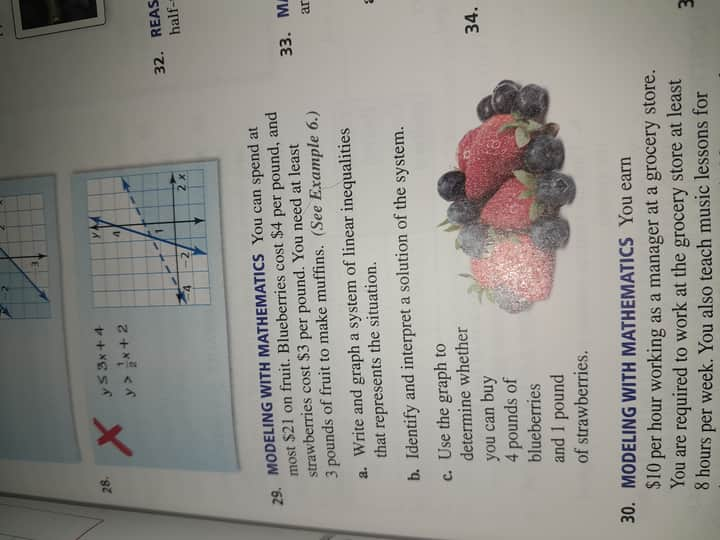Algebra 5.7 Number 29
Problem Statement:
The problem involves modeling a real-world situation using a system of inequalities. Here’s the breakdown of the task based on the image provided:
- You can spend at most $21 on fruit. Blueberries cost $4 per pound and strawberries cost $3 per pound. You need at least 3 pounds of fruit to make a muffin.
Part a: Writing the System of Linear Inequalities
To represent the situation with a system of linear inequalities, let’s first define the variables:
- Let ( x ) be the number of pounds of blueberries.
- Let ( y ) be the number of pounds of strawberries.
Now, let’s translate the conditions given in the problem into mathematical inequalities:
-
Cost Constraint: The cost of purchasing ( x ) pounds of blueberries and ( y ) pounds of strawberries must not exceed $21. Blueberries cost $4 per pound, and strawberries cost $3 per pound. Therefore, the inequality for the cost constraint is:
4x + 3y \leq 21.
-
Weight Constraint: You need at least 3 pounds of fruit in total. Therefore, the total weight of the blueberries and strawberries must be at least 3 pounds:
x + y \geq 3.
Part b: Identify and Interpret a Solution of the System
To identify and interpret a solution, we must find values of ( x ) and ( y ) that satisfy both inequalities.
Let’s solve this system graphically:
- First graph the line (4x + 3y = 21).
- Then graph the line (x + y = 3).
- Determine the region that satisfies both inequalities: 4x + 3y \leq 21 and x + y \geq 3
Interpretation: A solution to this system is any point ((x, y)) that lies in the overlapping shaded region of the graph. This point represents a combination of pounds of blueberries and strawberries you can purchase that meets both the budget and weight requirements.
Part c: Use the Graph to Determine Whether You Can Buy 4 Pounds of Blueberries and 1 Pound of Strawberries
To determine if you can buy 4 pounds of blueberries and 1 pound of strawberries:
-
Plug (x = 4) and (y = 1) into both inequalities:
-
Check the cost constraint:
4(4) + 3(1) = 16 + 3 = 19 \leq 21
So, this satisfies the cost constraint. -
Check the weight constraint:
4 + 1 = 5 \geq 3
This satisfies the weight constraint.
-
Since ((4, 1)) satisfies both inequalities, you can buy 4 pounds of blueberries and 1 pound of strawberries under these conditions.
Conclusion
The graph of this system visually represents feasible solutions to purchasing berries under budget and minimum weight constraints. This method allows you to determine whether specific combinations of blueberries and strawberries can be purchased without exceeding the budget and while meeting the weight requirement, such as buying 4 pounds of blueberries and 1 pound of strawberries. If you’d like a more in-depth explanation of specific algebraic methods used, feel free to ask! @Blibloop
